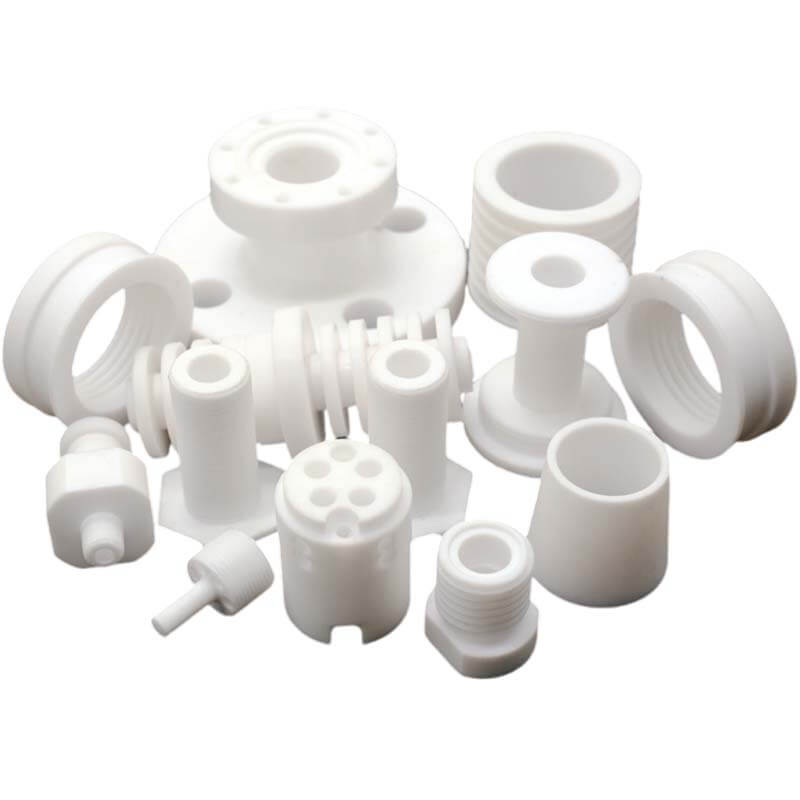PTFE CNC machining
PTFE CNC machining
Polytetrafluoroethylene (PTFE), commonly referred to as PTFE, possesses outstanding characteristics. It can endure an extreme temperature range from -200°C to 260°C for extended periods, displaying exceptional resistance to various chemicals and virtually impervious to corrosion from any chemical substances. Furthermore, PTFE boasts the lowest coefficient of friction among plastics, earning it the moniker “Plastic King.”
PTFE finds its primary applications in the electrical industry and is widely used in industries such as aerospace, aviation, electronics, instrumentation, and computers. It serves as an insulating layer for power and signal wires, making it an ideal choice for its corrosion-resistant and wear-resistant properties.

Some Picture of PTFE CNC machining Parts






PTFE CNC Machining FAQs
PTFE (Polytetrafluoroethylene) is A high molecular polymer prepared by polymerization of tetrafluoroethylene as a monomer. Polytetrafluoroethylene, commonly known by the brand name Teflon, is renowned for its low friction, non-stick properties, and resistance to chemicals and high temperatures. CNC machining of PTFE involves subtractive operations such as drilling, turning, threading, milling, and more to precisely shape PTFE materials, removing excess material, and cutting them into custom shapes.
PTFE (Polytetrafluoroethylene) is A high molecular polymer prepared by polymerization of tetrafluoroethylene as a monomer. olytetrafluoroethylene, commonly known by the brand name Teflon, is renowned for its low friction, non-stick properties, and resistance to chemicals and high temperatures. These properties make it a popular choice for CNC machining, as it can be used to create precision parts for applications in various industries, including automotive, aerospace, and electronics.
CNC machining offers several benefits when working with PTFE:
- High temperature resistance: PTFE material has excellent high temperature resistance, which can maintain the properties and appearance of the material at high temperatures.
- Chemical resistance: PTFE material has strong chemical resistance and can resist the erosion of acids, alkalis and other chemical agents.
- Anti-adhesion: The surface of PTFE material has very strong anti-adhesion performance, and it will not cause deposition or damage due to material adhesion for a long time.
- Electrical insulation: PTFE material has good electrical insulation performance, can be used in high voltage, high frequency and high temperature electrical equipment.
- Biocompatibility: PTFE material has excellent biocompatibility and can be used in the biomedical field.
- Complex geometries: CNC machining can handle intricate designs and tight tolerances.
PTFE CNC machining could make a lot of parts such as chemical instruments, containers, pipes and valves,blood filter and artificial blood vessel, fireproof clothing, high temperature filtration materials, aerospace materials and cable insulation materials, POTS, pipe fittings and automotive parts,press roll,seals and gaskets in brake systems, lubrication materials for engine components, insulation materials for motor coils.
Due to the weak intermolecular forces, low hardness, less-than-ideal wear resistance, poor surface energy, high coefficient of thermal expansion, inertness, and low thermal conductivity of PTFE, it results in its poor machinability. It is essential to use the right cutting tools, tool speeds, and feeds to prevent overheating and maintain material integrity during the machining process.
Common CNC machining techniques for PTFE include turning, milling, drilling, and routing. These techniques are used to shape PTFE into the desired form.
When machining PTFE, it’s crucial to use carbide or diamond-coated cutting tools. These tools are durable and capable of working with PTFE’s limited thermal conductivity. Proper tool geometry and sharpness are also essential to prevent overheating and material buildup on the cutting edge.
PTFE generates fine particles and dust during machining. It’s important to have effective dust collection systems and ventilation in place to ensure the safety of operators and to maintain a clean working environment. Personal protective equipment (PPE) like masks and eye protection may also be required.
Yes, PTFE parts can be post-processed, including cleaning, deburring, polishing, and applying surface finishes. These steps can improve the aesthetics and functionality of the final product.
Best practices for PTFE CNC machining include selecting the right cutting tools, optimizing tool speeds and feeds, using proper lubrication and cooling techniques, and adhering to safety measures. It’s also important to work with experienced machinists who understand the unique properties of PTFE.
PTFE CNC machining could be applied in many industries, for example, Chemical industry, Electronics industry, Medical industry, Environmental protection industry, Semiconductors industry, new energy industry, automotive industry, machinery industry, etc.
Free Sample
Explore More Plastic Materials

Stainless Steel CNC machining
Stainless steel is a corrosion-resistant, high-strength, and aesthetically pleasing metal material. Its primary components include iron, chromium, nickel, and other elements. By incorporating different elements and employing various techniques, stainless

PTFE CNC machining
Polytetrafluoroethylene (PTFE), commonly referred to as PTFE, possesses outstanding characteristics. It can endure an extreme temperature range from -200°C to 260°C for extended periods, displaying exceptional resistance to various chemicals

PEEK CNC machining
Polyetheretherketone (PEEK) is a special type of high-performance polymer material known for its high mechanical strength, resistance to high temperatures, impact resistance, flame retardancy, acid and alkali resistance, hydrolysis resistance,

